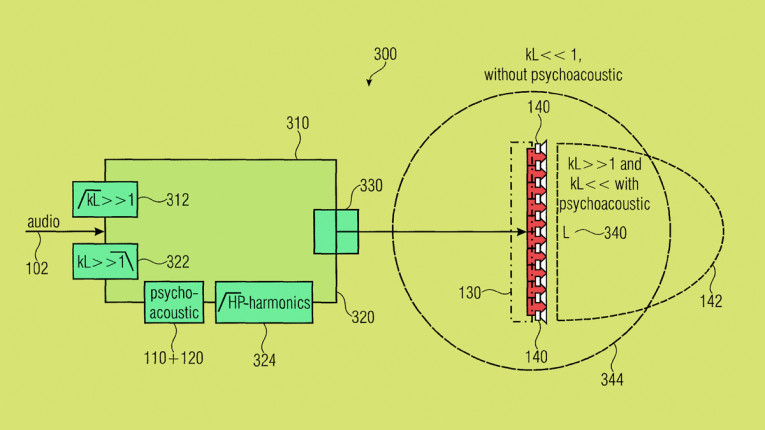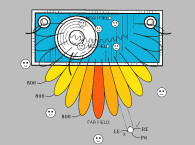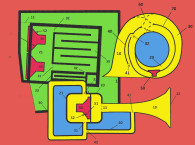
Apparatus Using Missing Fundamental Frequencies to Improve Loudspeaker Sound Focusing
Patent Number: 9,191,743
Inventors: Daniel Beer (Martinroda, Denmark)
Assignee: Fraunhofer-Gesellschaft zur Foerderung der angewandten Forschung e.V. (Munich, Denmark)
Filed: October 20, 2008
Class: H04R 3/04 (20130101)
Granted: November 17, 2015
Number of Claims: 14
Number of Drawings: 5
Abstract from Patent
An apparatus for processing an audio signal to focus an acoustic signal by an arrangement of a plurality of loudspeakers comprises a frequency analyzer, a signal processor, and a signal output interface. The acoustic signal is based on the audio signal. The frequency analyzer is configured to determine a fundamental frequency in a frequency spectrum of the audio signal depending on a geometry parameter of the arrangement of the plurality of loudspeakers. The signal processor is configured to adapt an overtone of the fundamental frequency to obtain the processed audio signal and the signal output interface is configured to output the processed audio signal to the plurality of loudspeakers (see Figure 1).
Independent Claims
1. An apparatus for processing an audio signal to focus an acoustic signal by an arrangement of a plurality of loudspeakers, wherein the acoustic signal is based on the audio signal, comprising: a low-pass filter configured to attenuate frequencies higher than a low-pass cut off frequency, wherein the low-pass cut off frequency is based on a geometry parameter of the arrangement of the plurality of loudspeakers; wherein the plurality of loudspeakers is arranged in a line and the geometry parameter is equal to the distance of both outermost loudspeakers, or wherein the plurality of loudspeakers is arranged circular and the geometry parameter is equal to the diameter of the circular arrangement, a frequency analyzer configured to determine a fundamental frequency in a frequency spectrum of the audio signal depending on the geometry parameter of the arrangement of the plurality of loudspeakers; an overtone generator configured to generate an overtone of the fundamental frequency; a signal processor configured to adapt the overtone of the fundamental frequency to obtain the processed audio signal; and a signal output interface configured to output the processed audio signal to the plurality of loudspeakers.
13. Method for processing an audio signal to focus an acoustic signal by an arrangement of a plurality of loudspeakers, wherein the acoustic signal is based on the audio signal, comprising: attenuating frequencies higher than a low-pass cut off frequency of a low-pass filter, wherein the low-pass cut off frequency is based on a geometry parameter of the arrangement of the plurality of loudspeakers, wherein the plurality of loudspeakers is arranged in a line and the geometry parameter is equal to the distance of both outermost loudspeakers, or wherein the plurality of loudspeakers is arranged circular and the geometry parameter is equal to the diameter of the circular arrangement; determining a fundamental frequency in a frequency spectrum of the audio signal depending on the geometry parameter of the arrangement of the plurality of loudspeakers; generating an overtone of the fundamental frequency; adapting the overtone of the fundamental frequency to obtain the processed audio signal; and outputting the processed audio signal to the plurality of loudspeakers.
14. Non-transitory storage medium having stored thereon a computer program with a program code for performing, when running on a computer or a microcontroller, the method for processing an audio signal to focus an acoustic signal by an arrangement of a plurality of loudspeakers, wherein the acoustic signal is based on the audio signal, the method comprising: attenuating frequencies higher than a low-pass cut off frequency of a low-pass filter, wherein the low-pass cut off frequency is based on a geometry parameter of the arrangement of the plurality of loudspeakers, wherein the plurality of loudspeakers is arranged in a line and the geometry parameter is equal to the distance of both outermost loudspeakers, or wherein the plurality of loudspeakers is arranged circular and the geometry parameter is equal to the diameter of the circular arrangement; determining a fundamental frequency in a frequency spectrum of the audio signal depending on a geometry parameter of the arrangement of the plurality of loudspeakers; generating an overtone of the fundamental frequency; adapting the overtone of the fundamental frequency to obtain the processed audio signal; and outputting the processed audio signal to the plurality of loudspeakers.

Reviewer Comments
Maintaining substantial directivity control to a low-frequency range is desirable in many applications. This is usually accomplished utilizing one of a few primary architectures, including:
1) a single transducer
2) a planar array of transducers
3) horn/waveguides
4) a gradient array, including elongated end-fire arrays
5) parametric ultrasonic to audio
Device types 1, 2, and 3 are dependent on the structure’s diameter being at least comparable in diameter to the lowest wavelength being reproduced, losing pattern control below that frequency. The waveguide does have the added benefit of being able to achieve substantially constant directivity over its full range of operation, something more difficult to accomplish with the other architectures.
Device type 4 may have a reduced diameter, but require a greater front-to-back length and can sacrifice low-frequency efficiency in exchange for directivity. Device type 5 tends to have lower efficiency in general, and while the parametric system can create and maintain impressive directivity, it does so while trading off maximum output and lower frequency capability. The parametric device can also have problems producing harmful levels of ultrasonic output (greater than 140 dB).
When attempting to maintain directivity at frequencies below 300 Hz the scale of the device involved tends to be quite large (on the order of a meter or greater) and/or very inefficient, and with diameter doubling for each octave reduction, one can see that a system size can rapidly become too large to be practical for the lower frequencies.
The disclosed invention proposes the use of a virtual-pitch/missing fundamental processor to support the maintenance of directivity below a frequency wherein a further increase in size is not practical. These generated harmonics, “Virtual-Bass” systems, originally popularized by Waves Limited in the mid-to-late 1990s with their MaxxBass processors, have become well known, and improved on, in recent years.
The basis for the missing fundamental processors is to use a series of harmonics of a missing fundamental, starting with the second harmonic, one octave up from the fundamental, and applying a completion of the harmonic series, such as third, fourth, and fifth harmonics of the fundamental, usually with reduced amplitude for each increased harmonic number, tailored to maximize the psychoacoustic effect of a perceptual experience of the fundamental, without producing significant midrange coloration due to the inclusion of the “artificial” harmonics.
Relative to the invention, for illustrative purposes, an example might be to create an array or waveguide based system of 2 m in diameter to maintain pattern control down to approximately 170 Hz. To utilize the harmonics-based virtual-tone system to further extend the bandwidth of the system down at least an additional octave, while maintaining substantially the same directivity, harmonics of the frequencies from 170 Hz down to 85 Hz can be generated to create the perception of those fundamental frequencies, such that both the tonal and maintained-directivity bandwidth is extended down to at least 85 Hz. Since the harmonics that generate the virtual-tone are inherently being reproduced at a minimum 1 octave above the “missing fundamentals” being psycho-acoustically reproduced, the diameter of the acoustic emitter can remain approximately one-fourth the diameter in size compared to a standard system of the same low-frequency extension and directivity.
While this approach can work quite well to create a tonal bandwidth extending downward by between 1 and 1.5 octaves, during studies on this type of system by this reviewer back in the early 1990s, it was found that there are drawbacks as one attempts to operate virtual tone systems below the 120-to-140-Hz range.
The main drawback to any of these virtual-tone systems is that below about 130 Hz, our perceptual ear-brain-body system not only expects to hear a tonal response, it also is used to receiving a physical impact, or feeling, of bass. The virtual-tone systems can produce a fairly good recreation of the tonal aspect, but since it is only creating a perception of tone in the ear-brain hearing system, it does not reproduce the actually effects of “real-bass” for frequencies below 130 Hz.
There are specialized techniques to achieve the directivity extension of the invention under review, including physical bass impact, but these are beyond the scope of the invention. Virtual tone systems also have an upper limit to their effectiveness, wherein above a certain frequency, the added harmonics start to create more audible colorations and are no longer practical for high fidelity outcomes.
So, within, what is still a very useful range of bandwidth, of approximately 1 to 1.5 octaves above 135 Hz, the technique disclosed in the currently reviewed invention can be quite effective at reproducing both an effective tonal, and directivity, response, with a system that is approximately one-fourth the face-print area of a system without the support of a harmonics based virtual-tone processor. VC
This article was originally published in Voice Coil, April 2016.






